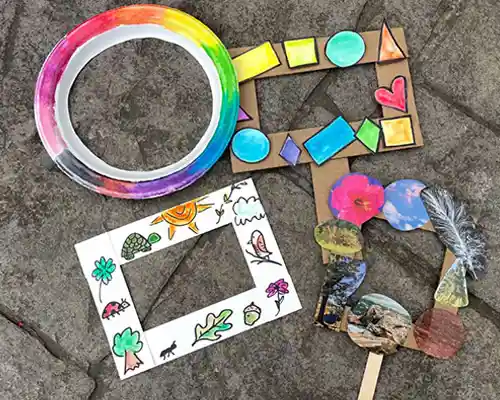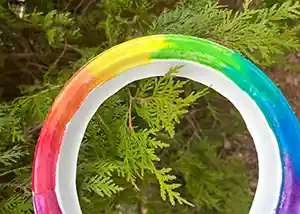Nature Viewers

Nature Activities for Preschoolers
Whether your outdoor adventures take place in familiar surroundings or new spaces, these
simple do-it-yourself frames bring a fresh and focused lens to your explorations with young children.
Ages/Grades
Toddlers (with supervision and support), Preschool, Early Elementary
Learning Domains
Science & Inquiry
Language Development
Approaches to Learning
Perceptual, Motor and Physical Development
Creative Expression
Materials:
- • Picture mats or cardboard, cardstock, tagboard, heavy watercolor paper or other sturdy material
- • Strong adhesive:
- • If children are assembling their own frames try Glue Dots (strong hold and no dry time) or Tacky Glue (strong bond, but need to plan for drying time)
- • Teacher assembly: hot glue is a strong and quick adhesive
- • Materials to decorate:
- • Paint
- • Paint sticks
- • Magazines or other media for collage images
- • Glue or glue sticks for adhering collage images
- • Contact paper (optional)
- • Dry-Erase Markers (optional)
Ready, Set, Create!
![]() Gather materials and prepare frames. If children are assembling their own frames, prepare uniform strips that they can glue to create squares or rectangles.
Gather materials and prepare frames. If children are assembling their own frames, prepare uniform strips that they can glue to create squares or rectangles.
![]() Provide children with the cardboard strips and adhesives to assemble their frames.
Provide children with the cardboard strips and adhesives to assemble their frames.
![]() Decorate with paint, paint sticks, or collage images.
Decorate with paint, paint sticks, or collage images.
Extensions
• Cover with clear contact paper. Children can trace what they view with a dry-erase marker.
• Add a cardboard or craft stick handle.
• Focus on a specific topic or theme:
- Nature’s Rainbow Frame - Find things to match the colors on the frame. Color the outside of the frame so students can match the colors they see outside. You can easily add shades of natural colors using paint color swatches. For older students, make frames that are all shades of one color.


- Shapes Frame - Find things to match the shapes on the frame. Draw simple shapes around the outside of the frame. Experiment with adding more complex or nature-centric shapes.
- Cloud/Leaf/Flower/Rock ID Frame - Use the frame to find and identify. Print pictures or add illustrations to help students identify and sort what they see. This can be modified for any theme/exploration

- Where is the Water? Frame - Find evidence of the water cycle - puddles, condensation, clouds. Add the stages of the water cycle around the outside of the frame.
- Living/Non-living Frame - Find things that are living and non-living. On one side of the frame, illustrate the features of living things. On the other side, illustrate the features of non-living things. Alternatively, you can add living and non-living photos/illustrations to either side.
- Nature Counts Frame - Set a goal (find 10 leaves, rocks, bugs, anything!) and encourage your students to keep track on the edge of the frame.This is a mostly blank frame with space for students to make tick marks to keep track of observations.
- "I Wonder" Frame - Find and frame something that makes you curious. These frames can be decorated by the students themselves! Print “I Wonder” on the frame and let them make it their own!
 Hollie is certified K-8 teacher who has been educating in the informal education field since 2005. She has developed and implemented countless exciting STEAM programs for families, classrooms, and teachers focused on the natural world, the scientific process, and ancient life. Her professional passions are inquiry, whole family learning, experiential learning starting in early childhood, and the intersection of literacy and science instruction.
Hollie is certified K-8 teacher who has been educating in the informal education field since 2005. She has developed and implemented countless exciting STEAM programs for families, classrooms, and teachers focused on the natural world, the scientific process, and ancient life. Her professional passions are inquiry, whole family learning, experiential learning starting in early childhood, and the intersection of literacy and science instruction.
She has recently developed a community-based program that encourages families to use dramatic play to learn science, increase literacy skills, and have fun together for which she received the Drexel University Presidential Award for Civic Engagement. She is most proud of her work on a popular science storytelling program for preschool families and classrooms that combines a book club format with engaging programs, innovative curriculum, and a hysterical puppet storyteller.
